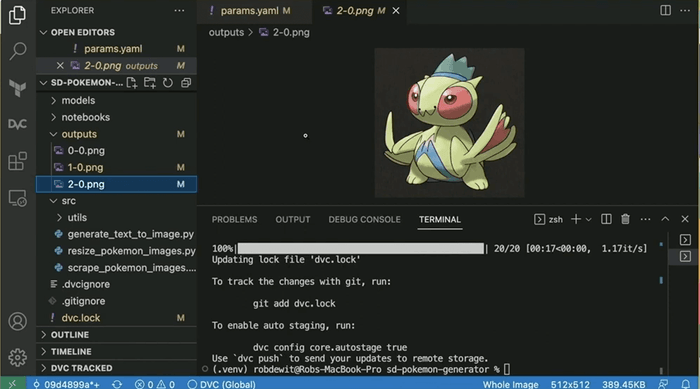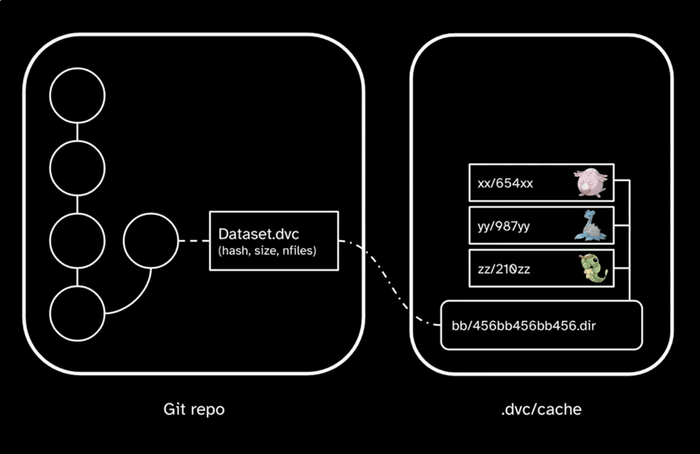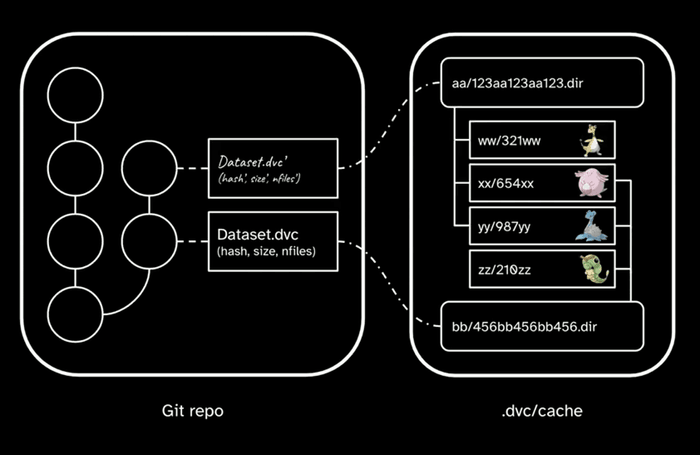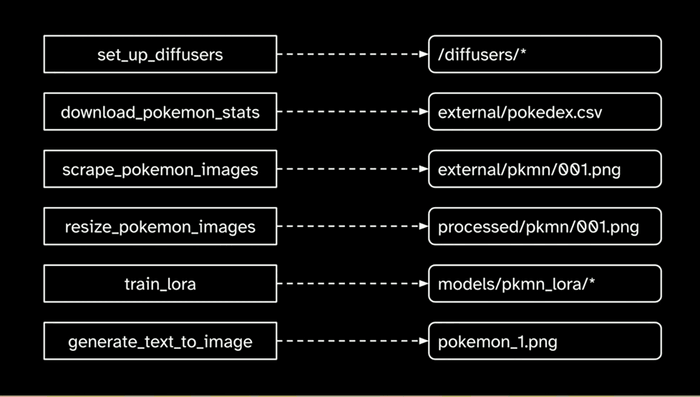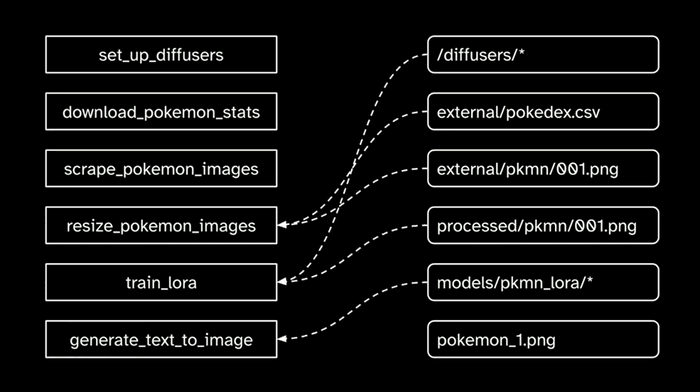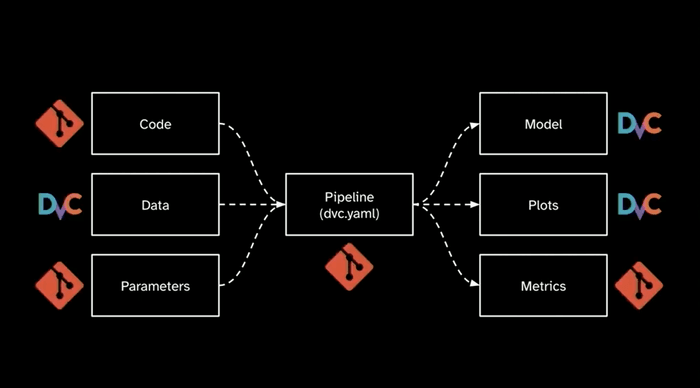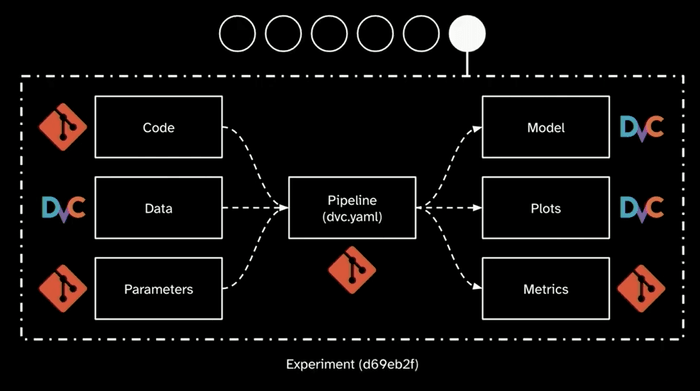Transforming a Jupyter Notebook into a Reproducible Pipeline for Experiments with DVC
This blog post is an adaptation of Rob De Wit’s presentation on the subject using his Pokémon Generator project at PyData USA 2023. You can find the video here and the repo of the project here.
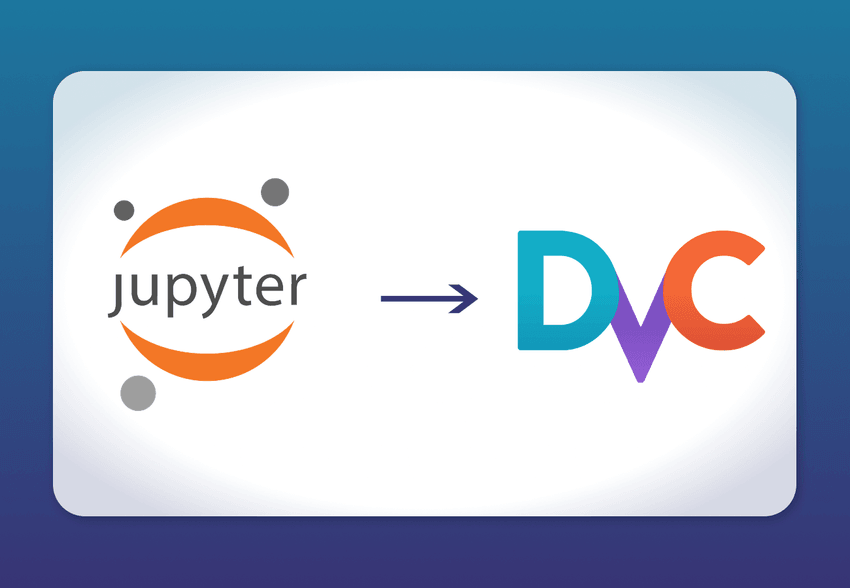
Learn how to transform your Jupyter Notebook prototype into a production-ready DVC pipeline.
When we experiment with machine learning models, it’s easy to get lost in the cycle of trying new parameters, swapping datasets, or adjusting architectures. That’s how progress is made, but without structure, reproducibility, and tracking, you risk losing valuable results or being unable to explain why a model worked (or failed).
In this post, I use a Pokémon generator I created with LoRA (Low-Rank Adaptation of Large Language Models) to demonstrate how I approach turning one-off prototypes into structured, reproducible pipelines using versioned data, parameters, and experiments.
Why Reproducibility Matters
Reproducibility is the backbone of science, and machine learning is no different. A reproducible experiment means:
- The same combination of data, code, and parameters produces the same result.
- You can trace back decisions: which dataset, which hyperparameters, which preprocessing steps.
- Collaboration can be acheived. Your colleagues (and your future self!) can understand and build upon your work.
When I worked on earlier projects, we often had to reconstruct models after the fact, trying to remember what went into training them. That experience convinced me that reproducibility should be built into every pipeline from day one. That’s why I treat every experiment as a deterministic combination of code + data + parameters, and I build pipelines that make this explicit.
Moving from Jupyter Notebook to a Reproducible Pipeline
Jupyter notebooks are a great tool for prototyping data science projects, but not the best go-to when needing to reproduce your results. Part of the greatness is the ability to easily change cells and re-run sections, visualize data in-line with code, and share analysis with narrative text. But on the flip side, these benefits can lead to a breakdown in your ability to accurately reproduce results. Notebooks are also challenging to test, scale, and manage dependencies. So how can we set up our pipeline for reproducible success?
Enter DVC
If you’ve ever tried to manage large files with Git, you have come to realize that Git in and of itself is not sufficient. DVC operates like Git, but for large data, models, and your machine learning experimentation process, versioning everything along with the code. Let’s see how this works under the hood.
How DVC tracks your Data
In your Git repository, you have a main branch with commits and a branch with a dataset, in this case a dataset of Pokémon images.
As image data are large, we do not want to keep them in Git so DVC replaces them with a metadata file. The metadata for the dataset contains the hash, the size, number of files, and other data.
The hash in Git points to the .dvc/cache, which is where the physical images are actually stored on your file system.
If you create another commit with a different dataset (noted by a different font on the left in the Git repo). A new hash will point to the new dataset in the .dvc/cache. In this case, one image was removed and one added with two staying the same.
How a DVC Pipeline Works
Below you will find the sections of the Jupyter Notebook on the left. Each of these stages produces outputs as seen on the right.
As these are now specified, they can be used as downstream dependencies for other stages.
So if the train_lora stage is dependent on the processed images, we can ensure
that the stage only triggers once there are new images in the processed
directory. Additionally, if we make a change in the train_lora stage, none of
the previous stages that were not changed will need to be run with DVC, saving
you development time.
How Tracking Experiments Work with Git and DVC
In addition to your data and pipeline, DVC can version your experiments along with Git. We use DVC for larger files and Git for the smaller files.
All of these things together represent an experiment and can be recorded as a
git commit with a hash. This way this experiment and all its modifications will
be able to be reproduced using a git checkout and dvc checkout with its hash
(See experiment hash noted at bottom.)
Converting from a Jupyter Notebook to a DVC Project
We will set up our Pokémon generator as a DVC project.
Building the Pipeline
Here’s the approach I’ve taken to bring structure into experimentation:
- Start with a Base Model. Use an off-the-shelf model as your foundation. Fine-tune it, adapt it, and make it your own, but always know what version you started from.
- Track Everything. Every dataset, parameter, and code change should be versioned. We can use DVC for this. Think of it like Git for your machine learning workflow: commits that point not just to code, but to data and model states.
- Modularize the Workflow. Break experiments into stages: data prep, training, evaluation, etc. That way, you can rerun only what changes instead of starting from scratch every time.
- Run Reproducible Experiments. Each experiment should be captured so you can roll back, compare results, and build confidence in the best-performing model.
- Move Toward Production. Once an experiment proves itself, package it into a pipeline that can run with a single command. That pipeline is what bridges the gap between “something interesting in a notebook” and “a reliable system in production.”
Step 1: Define the Pipeline
Start by breaking your workflow into stages. For example, in this project the dvc.yaml looks like this:
stages:
set_up_diffusers:
cmd: |
git clone --depth 1 --branch v0.14.0 https://github.com/huggingface/diffusers.git diffusers
pip3.10 install -r "diffusers/examples/dreambooth/requirements.txt"
accelerate config default
outs:
- diffusers:
cache: false
scrape_pokemon_images:
cmd: python3 src/scrape_pokemon_images.py --params params.yaml
deps:
- src/scrape_pokemon_images.py
outs:
- data/external/pokemon
download_pokemon_stats:
cmd:
kaggle datasets download -d brdata/complete-pokemon-dataset-gen-iiv -f
Pokedex_Cleaned.csv -p data/external/
outs:
- data/external/Pokedex_Cleaned.csv
resize_pokemon_images:
cmd: python3 src/resize_pokemon_images.py --params params.yaml
deps:
- src/resize_pokemon_images.py
- data/external/pokemon
- data/external/Pokedex_Cleaned.csv
outs:
- data/processed/pokemon
params:
- base
- data_etl
train_lora:
cmd: >
accelerate launch --mps
"diffusers/examples/dreambooth/train_dreambooth_lora.py"
--pretrained_model_name_or_path=${train_lora.base_model}
--instance_data_dir=${data_etl.train_data_path}
--output_dir=${train_lora.lora_path} --instance_prompt='a pkmnlora
pokemon' --resolution=512 --train_batch_size=1
--gradient_accumulation_steps=1 --checkpointing_steps=500
--learning_rate=${train_lora.learning_rate} --lr_scheduler='cosine'
--lr_warmup_steps=0 --max_train_steps=${train_lora.max_train_steps}
--seed=${train_lora.seed}
deps:
- diffusers
- data/processed/pokemon
outs:
- models/pkmnlora
params:
- data_etl
- train_lora
generate_text_to_image:
cmd: python3 src/generate_text_to_image.py --params params.yaml
outs:
- outputs
deps:
- src/generate_text_to_image.py
- models/pkmnlora
params:
- train_lora
- generate_text_to_imageEach stage declares:
- Command (cmd) – what to run
- Dependencies (deps) – inputs the stage needs
- Outputs (outs) – files the stage produces. This way, when you change a dependency (e.g., a new dataset or updated parameter), only the affected stages re-run.
Step 2: Track Parameters
Instead of hardcoding hyperparameters, keep them in a structured file like params.yaml:
base:
train_pokemon_type: all
data_etl:
external_data_path: 'data/external/'
train_data_path: 'data/processed/pokemon'
train_lora:
seed: 1337
model_directory: 'models'
base_model: 'runwayml/stable-diffusion-v1-5'
lora_path: 'models/pkmnlora'
learning_rate: 0.0001
max_train_steps: 15000
generate_text_to_image:
seed: 3000
num_inference_steps: 35
batch_size: 1
batch_count: 20
prompt: 'a pkmnlora pokemon'
negative_prompt: ''
output_directory: 'outputs'
use_lora: TrueNow you can run controlled experiments:
$ dvc exp run -S training.learning_rate=0.01This will execute the pipeline with the updated parameter, track the run, and save results.
Step 3: Track Experiments
For this Pokémon project, it’s not as relevant because the results are images with subjective grading. But with projects where you’re tracking metrics, with pipelines defined and parameters externalized, you can now compare experiments systematically:
$ dvc exp showExample output:
| Experiment | train.learning_rate | train.epochs | Accuracy | Loss |
|---|---|---|---|---|
| baseline | 0.001 | 10 | 0.82 | 0.41 |
| exp-1234 | 0.01 | 10 | 0.85 | 0.37 |
| exp-5678 | 0.001 | 20 | 0.84 | 0.39 |
This makes it easy to see how parameter changes affect performance—without losing reproducibility.
Step 4: Move Toward Production
Once you’re confident in a pipeline:
- Lock the configuration – commit your dvc.yaml and params.yaml.
- Version your data – every dataset version is tracked (no guessing which CSV was used).
- Promote a model – move the best checkpoint into a production/ folder or model registry. Then your entire workflow can be reproduced with a single command:
$ dvc reproThat runs the whole pipeline—data prep, training, evaluation—with the exact same inputs and parameters.
Lessons Learned
- Reproducibility = productivity. You spend less time debugging “mystery results.”
- Experiment tracking is collaborative. Colleagues can see exactly what you tried, what worked, and what didn’t.
- Pipelines scale. What starts as a notebook prototype can evolve into a production-ready workflow.
Final Thoughts
Experimentation will always be messy—but pipelines don’t have to be. By structuring workflows into reproducible pipelines, you get the freedom to explore while ensuring you can always reproduce and explain your results. If you’d like to try this yourself, check out the example pipeline repo and the docs for more info on building workflows specific to your project.
📰 Join our Newsletter to stay up to date with news and contributions from the Community!

